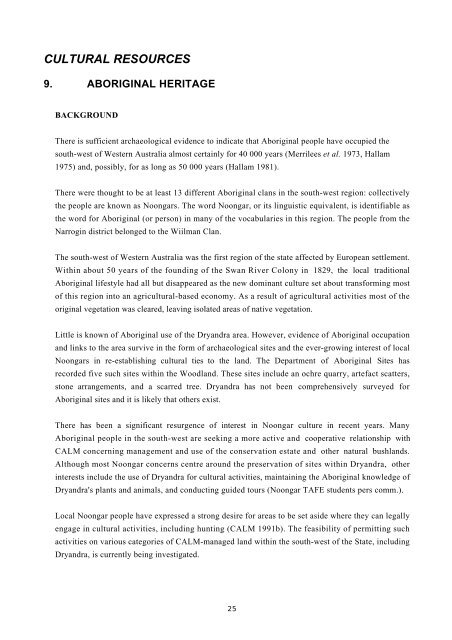Dryandra Woodland - Department of Environment and Conservation ...
Dryandra Woodland - Department of Environment and Conservation ...
Dryandra Woodland - Department of Environment and Conservation ...
Create successful ePaper yourself
Turn your PDF publications into a flip-book with our unique Google optimized e-Paper software.
CULTURAL RESOURCES<br />
9. ABORIGINAL HERITAGE<br />
BACKGROUND<br />
There is sufficient archaeological evidence to indicate that Aboriginal people have occupied the<br />
south-west <strong>of</strong> Western Australia almost certainly for 40 000 years (Merrilees et al. 1973, Hallam<br />
1975) <strong>and</strong>, possibly, for as long as 50 000 years (Hallam 1981).<br />
There were thought to be at least 13 different Aboriginal clans in the south-west region: collectively<br />
the people are known as Noongars. The word Noongar, or its linguistic equivalent, is identifiable as<br />
the word for Aboriginal (or person) in many <strong>of</strong> the vocabularies in this region. The people from the<br />
Narrogin district belonged to the Wiilman Clan.<br />
The south-west <strong>of</strong> Western Australia was the first region <strong>of</strong> the state affected by European settlement.<br />
Within about 50 years <strong>of</strong> the founding <strong>of</strong> the Swan River Colony in 1829, the local traditional<br />
Aboriginal lifestyle had all but disappeared as the new dominant culture set about transforming most<br />
<strong>of</strong> this region into an agricultural-based economy. As a result <strong>of</strong> agricultural activities most <strong>of</strong> the<br />
original vegetation was cleared, leaving isolated areas <strong>of</strong> native vegetation.<br />
Little is known <strong>of</strong> Aboriginal use <strong>of</strong> the <strong>Dry<strong>and</strong>ra</strong> area. However, evidence <strong>of</strong> Aboriginal occupation<br />
<strong>and</strong> links to the area survive in the form <strong>of</strong> archaeological sites <strong>and</strong> the ever-growing interest <strong>of</strong> local<br />
Noongars in re-establishing cultural ties to the l<strong>and</strong>. The <strong>Department</strong> <strong>of</strong> Aboriginal Sites has<br />
recorded five such sites within the <strong>Woodl<strong>and</strong></strong>. These sites include an ochre quarry, artefact scatters,<br />
stone arrangements, <strong>and</strong> a scarred tree. <strong>Dry<strong>and</strong>ra</strong> has not been comprehensively surveyed for<br />
Aboriginal sites <strong>and</strong> it is likely that others exist.<br />
There has been a significant resurgence <strong>of</strong> interest in Noongar culture in recent years. Many<br />
Aboriginal people in the south-west are seeking a more active <strong>and</strong> cooperative relationship with<br />
CALM concerning management <strong>and</strong> use <strong>of</strong> the conservation estate <strong>and</strong> other natural bushl<strong>and</strong>s.<br />
Although most Noongar concerns centre around the preservation <strong>of</strong> sites within <strong>Dry<strong>and</strong>ra</strong>, other<br />
interests include the use <strong>of</strong> <strong>Dry<strong>and</strong>ra</strong> for cultural activities, maintaining the Aboriginal knowledge <strong>of</strong><br />
<strong>Dry<strong>and</strong>ra</strong>'s plants <strong>and</strong> animals, <strong>and</strong> conducting guided tours (Noongar TAFE students pers comm.).<br />
Local Noongar people have expressed a strong desire for areas to be set aside where they can legally<br />
engage in cultural activities, including hunting (CALM 1991b). The feasibility <strong>of</strong> permitting such<br />
activities on various categories <strong>of</strong> CALM-managed l<strong>and</strong> within the south-west <strong>of</strong> the State, including<br />
<strong>Dry<strong>and</strong>ra</strong>, is currently being investigated.<br />
25

















